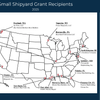Learn a Lasting Lending Lesson
Two key lending practices and today’s workboat market conditions collide on the waterfront. Which course you choose depends on where you sit.
Unless you are involved with your company’s borrowing and credit issues, you may not be well versed in the two principal types of commercial lending. Asset based Lending (ABL) and Cash Flow Lending (CFL) – the cornerstones of commercial credit – are also, in most respects, as different as night and day. Typically, company finance officers must decide between the two, and, as it turns out, some companies are more suited to one or the other. For companies with the luxury of choice, the pros and cons of each option should be weighed carefully.
Credit 101
Credit is a key element in growth. It is also a means to remain in business in challenging times. ABL, for example, is a specialized loan product that provides a borrower the ability to fully collateralize a short term loan with the equity available from the company’s asset pool. This pool can contain hard assets, like tugs and barges, be secured by accounts receivable, or be collateralized by intellectual property. It is a flexible source of funding that can be utilized by both healthy companies and those not so healthy.
To the former, it reflects the ability to monetize assets without violating other restrictive covenants. To the latter, it may function as a lifeline to turnaround, recapitalize or add enterprise value to a company in bankruptcy (debtor-in-possession or DIP) as an ongoing business entity has more value to creditors than does a closed firm whose assets have been liquidated.
For those companies operating on a seasonal basis, in particular the many dinner, excursion, freight and passenger vessels that ply Northern waters, revenues are often inconsistent and are dictated by weather, but balance sheets can be hefty. For companies with low margins, disturbed cash flow and large balance sheets, ABL provides the ability to tap into those large balance sheets as ABL lenders determine the amount of credit to be extended based on the liquidation value of the assets in the business’ asset pool, not on future earnings. Since lenders are relying on a known collateral value, there is inherently less risk on the lender’s behalf. Consequently, an ABL loan may carry a lower rate and be more forgiving of the financial condition of the borrower.
However, an ABL lender observes the borrower’s financial condition with more scrutiny, carefully monitoring receivables, inventory, asset condition and valuation. Reporting requirements by the borrower will be more frequent and detailed than in a CFL facility. The maturity is usually short term allowing the lender to adjust the terms of the loan’s amount, advance rate, reporting requirements, interest rates, etc. However, the increased reporting may be offset inasmuch as ABL loans do not normally include financial covenants whereas a CFL loan probably will.
An ABL loan usually takes the form of a revolving line of credit (RLOC) which is based on a fixed amount that is replenished when exhausted or by time (days, months, etc.). Two types of RLOCs are available: cumulative and non- cumulative. In the first, the unutilized sum is carried over to the next period, in the second type, it is not.
Cash Flow Loans
A cash flow loan suits a different borrower profile. It is based on future revenue and the ability to service the debt from those future sums. Limits are set by the CFL loan are more suitable to higher margin companies whose balance sheets are considerably more leveraged or have fewer hard assets to back up the loan request. In considering a loan request the amount may be limited by the lender to the borrower’s enterprise value, or the value of the entire company (tangible net worth). A CFL loan may contain financial covenants that borrowers must comply with. Covenants will typically include three or four covenants including:
- Fixed Charge Covenant: this covenant measures the borrower’s ability to service the company’s fixed financing expenses such as loans and leases.
- Debt to Net Worth (Leverage): this covenant measures the borrower’s total liabilities divided by its total shareholder value.
- Capital Expenditure Covenant: Limits the borrower’s ability to spend for capital expenditures (money spent to buy or add value to fixed assets extending the useful life past the taxable year.)
In the past failure to meet a covenant meant asking your lender for a waiver which was usually granted. Today, bank regulators are pressuring lenders to discontinue this practice. Compliance is critical as failure to meet a covenant’s requirement can result in default and the lender “calling the loan.” Where these metric meet is in the importance of the collateral in the transaction. Certainly the ability to repay the debt is important, but without collateral, making a case for financing is nearly impossible. Although “signature” or “personal” loans exist, they are usually provided by a lender at a much higher rate than those secured by conventional assets. That said; the five “Cs” of Credit still apply:
- The Character of the borrower;
- The Capacity of the borrower to repay the debt;
- The Capital the borrower puts toward the purchase of the Collateral;
- The Collateral that secures the loan; and
- The Conditions, such as interest rate, term and advance that convince the lender to lend to you.
If opportunity comes knocking and you need to visit your commercial marine banker, you now know your ABL’s from your CFL’s. Use this knowledge to your considerable advantage.
(As published in the October 2015 edition of Marine News - http://magazines.marinelink.com/Magazines/MaritimeNews)














